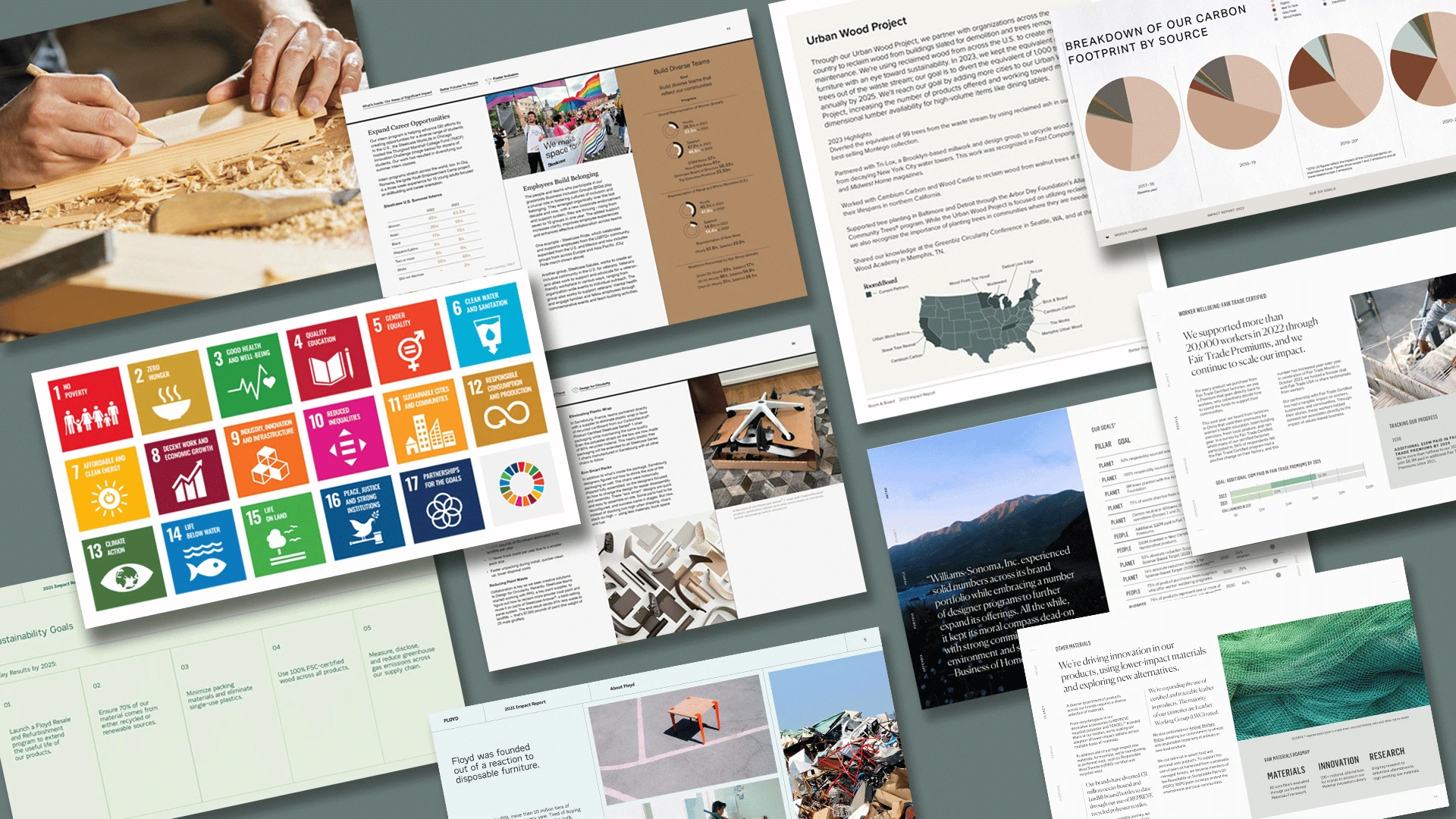
Impact Reporting: Opportunities for change
26-Jun-2024
Building accountability into the furniture industry
Webinar & Action Guide Series
Welcome to part 3 of our Action Guide & Webinar series - ‘Impact Reporting for Change | Building Accountability into the Furniture Industry.’ This is the 3rd and final Action Guide in the series, which explores the transformative possibilities of impact reporting in the world and business of furniture.
From the moment the first human sat upon a fallen tree, to the emergence of the most technologically advanced task chair, furniture has always been, and will continue to be, an unspoken language in our lives. Furniture steers our behavior and, like the bowerbird, allows us to make our home, work and leisure spaces attractive, comfortable and personal.
Yet, for all its benefits, furniture is responsible for a proliferation of ‘impacts’ - from deforestation to labor violations. The more we shift to a globalized trade model, the more distant we become from the artisans who craft our furniture and the forests that supply our timber. This distance only adds to the likelihood of a build-up of negative socio-environmental impacts along the supply chain.
This is where impact reporting comes in - as a means through which a company can assess what is going on and what can be done to transform its negative impacts into positive outcomes. The more companies that recognize the importance of pausing, evaluating and reporting on their impacts, the greater the movement of the furniture industry to a more sustainable future.
Our 3-part Action Guide series aims to support furniture companies in taking these steps towards greater transparency and accountability and making the leap further into sustainability:
- In Part 1 of our Action Guide series, we looked at the purpose behind reporting, the benefits it brings and key content to include in your reports.
- In Part 2 we explored the nuts and bolts of reporting - how to identify, understand and prioritize your impacts and where to find the information you need to build your report.
- Now, in Part 3, we will be exploring impact reporting as a tool for creating change within your company, finding opportunities that can grow into a strategic plan that becomes a roadmap for change.
Part 3 of 3: Opportunities For Change

If you have been following our three-part Action Guide, you may have started answering the four key questions that precede any impact reporting process - ‘Who does my business impact, and who impacts my business?’ and ‘What does my business impact and what impacts my business?’ (If you haven’t yet read Action Guide #1 and Action Guide #2, you’ll likely find it valuable to skip back to these first).
Answering these four questions provides an overview of your key stakeholders and primary impacts. You might have started a materiality assessment -- an internal and external ranking of your biggest impacts – covered in Action Guide #2 -- to see where to focus your efforts. You may have even sketched out the bare bones of a plan of action. This third Action Guide is here to help you grow that plan and put some meat (or tofu) on its bones.
The benefits of reporting are vast, from keeping track of progress to building customer trust and loyalty. But the higher purpose of reporting is to become part of a global shift. We live in a world in which the Global North creates far more than its fair share of carbon emissions - 92% - and is only beginning to feel the effects of climate breakdown. At the same time, the Global South contributes just 8% to global emissions, yet often experiences the full force of a changing climate.
Global inequity is becoming as much a driver for change as climate breakdown and biodiversity loss. In a world experiencing rapid transformation, it is as important to both address damage already done, as well as to build resilience to a changing planet - and build resilience into your business. One thing is certain - change is gonna come.
In this third part in our series on impact reporting, we will explore how the challenges and risks your company faces can be turned into opportunities that lead to fundamental shifts and gains within your company. We will examine different tools for identifying risks and opportunities that help build business resilience and a competitive edge, and explore a host of real-life examples in which the tracking and reporting process has been used to spot trends and grasp opportunities - that lead to developing and implementing action plans for change.
Spotting what might have been missed
Impact reporting often makes us look at things we might prior have never even considered. In conducting a materiality assessment, for example, your external stakeholders might have flagged a topic as a higher priority than you expected, or even picked-up on a topic that you overlooked. Or maybe, by including a diverse mix of colleagues in your internal stakeholder discussions, you came across opportunities you may have missed.
Gaining visibility into where you have been, and where you are heading, is a key step in the journey to change. In its 2023 Impact Report, for example, US-based manufacturer Steelcase (below) looked at the racial demographics of its interns across a two-year period. It would be easy to miss the opportunity to ‘connect the dots’ if the company were not tracking these metrics. With this data, Steelcase will be able to strengthen diversity and equity within its internship program.

In its 2023 Impact Report, US manufacturer Steelcase reports on the diversity of its summer internship program as well as on the growing inclusion fostered by its grassroots Business Inclusion Groups. These groups are endorsed and supported by the company’s leadership team.
Look for opportunities
As you identify your key areas of impact, the reporting and strategy development process invites you to identify new opportunities on the path of your sustainability journey - the potential to build both business resilience, reduce negative environmental or social impacts, and/or bring benefits to your organization, its workforce and the wider community. The longer your vision, the more you will be able to see that ‘good for people and the environment’ will go hand in hand with ‘good for business.’
The key idea in ‘looking for opportunities’ is that what you initially discover as obstacles or stubborn problems - may in fact lead to new, creative, healthier and, ultimately, cost-saving or more profitable solutions. Opportunities you discussed when you carried out your materiality assessment (see Action Guide #2 in this series) are absolute gold dust when it comes to building a picture of possibilities ahead. Opportunities come in many different guises and in many different areas - in sales and marketing, in community and supplier engagement, in materials or product design, in the potential for accreditation and certification, and for new business models - the list is endless!
A risk and opportunity approach forms the basis of many aspects of work in the field of sustainability, including work towards ISO 14001 accreditation (environmental management systems) and strategy development. Recognizing opportunities can also help build buy-in across your organization for the impact assessment process - as sustainability improvements often lead to commercial benefits.
Creating your company’s strategy by assessing risks and opportunities will help greatly in building resilience and future proofing your business. Look to enlist the help of your colleagues who are natural ‘horizon scanners’ and ‘lateral thinkers’ - these are often the teammates who have their fingers most closely on the pulse of what’s happening and what’s to come.
To help determine the threats or risks to your organization, think about all the topics you listed when carrying out your materiality assessment. It is also helpful to pour over the impact reports of many other furniture-related companies, as well as the sustainability pages of your competitors.

Reviewing the impact reports of other furniture-related companies can be very helpful in ‘jogging your thinking’ when seeking to identify potential areas of risk and/or opportunity in your business.
3 tools for identifying risks & opportunities
1. SWOT ANALYSIS
Reporting not only improves performance across all three bottom lines - people, planet and profit - it also helps build resilience. Taking a long, hard look at the impact of your business can bring insights into areas where your operations might be weak.
Even a really simple S.W.O.T. analysis - Strengths, Weaknesses, Threats and Opportunities - can reveal great opportunities for change. Take a look at the SWOT analysis, below, of a fictional furniture retailer designing in the US and importing goods from the Far East.
To create your own SWOT analysis, gather a small team of colleagues and first make a list of the key strengths of your business. In addition to listing strengths in terms of sustainability-related issues, also identify what else is really great about your organization. We encourage you not to rush, as this can be a really positive set of messages to use in marketing and to feed back to your team.
Next, look at weaknesses. What facets of your company aren't so great and are in need of improvement? These are hopefully issues that the senior team is well aware of and paying attention to improving.
Then, look at threats that your company faces. These might be in terms of competition, performance or anything related to global supply chains and a changing planet - from extreme weather events to insecurity and delays in supply of materials. A long-term vision for threats facing your company is truly important. Assessing them is a skilled task, and it will be your risk-averse peers who come into their own here!
As you go, refine, organize and prioritize the ideas in each category so that the most important - or ‘material’ - issues sit at the top of each section of your SWOT table.
Finally, in the 4th quadrant, think about opportunities. In addition to opportunities generated by changes in the market, think about opportunities embedded in the ‘flip side’ of the threats your business faces - that is, the changes needed to strengthen your company. This is where you can start to build the outline of your sustainability action plan.

Table 1. This is a sample SWOT analysis for a fictional retailer of imported furniture. The lower-right quadrant shows how the company identified opportunities in relation to production, sales and marketing. These include the potential for increasing the company’s focus on fairly traded goods, local manufacturing, accreditations and certifications, and storytelling in relation to supplier engagement. Additional opportunities include increased community engagement through second-hand furniture sales, along with upskilling team members. Each of these can help strengthen both market positioning and business resilience.
2. PESTLE ANALYSIS
Another great tool for identifying opportunities is a P.E.S.T.L.E. analysis. This tool takes a more nuanced and wide-angle look at a company’s position in terms of external market forces. These are related to both the current and future Political situation, Economic environment, Social context, role of Technology, Legal issues and Environmental challenges.
A PESTLE analysis is sometimes used to support a SWOT analysis, and vice versa. While you want to ensure diversity of perspectives and adequate depth to make assessment meaningful, you also need to guard against ‘analysis paralysis.’ Remember, the goal here is to assess risks and opportunities and build a plan of action. It may be helpful to start out with a high level objective as to what you most want to achieve. One such objective might be ‘to assess the external market forces impacting our organization, looking for risks and opportunities to improve our performance across social, environmental and economic levels.’
In conducting a PESTLE analysis, start with P for ‘Political.’ Consider issues like national and global political stability, foreign trade policies, and potential for political unrest. Then, under ‘Economic,’ ask yourself ‘How does the current and likely future economic situation impact our organization?’ Think about factors such as inflation, interest rates, economic growth, unemployment rates, exchange rates, and the rise of cryptocurrency.
Next, ‘Social’ factors include changing attitudes, opinions and behaviors; changing demographics; increased demand for more ‘sustainable’ and ethically produced products; and the shift toward working from home. In the ‘Technological’ section, think about the role of AI, emerging technologies such as video conferencing, cyber security and industry innovation. ‘Legal’ aspects will include current and upcoming regulations such as the EU Ecodesign Directive, or how mandatory reporting requirements will impact your company. Finally, the ‘Environmental’’ section will cover aspects such as climate change, natural disasters and the long term availability of resources.
To streamline this process, focus on one section at a time. Sort the risks your company faces into each of the six categories - Political, Economic, Social, Technological, Legal and Environmental. For each risk, add a related opportunity and rank these risks according to their material relevance.
A PESTLE analysis forces a company to take a more long-term view of what it is doing and how it is doing it. Through the wider lens and context of this in-depth methodology, you can unearth many opportunities that a SWOT analysis may not reveal.
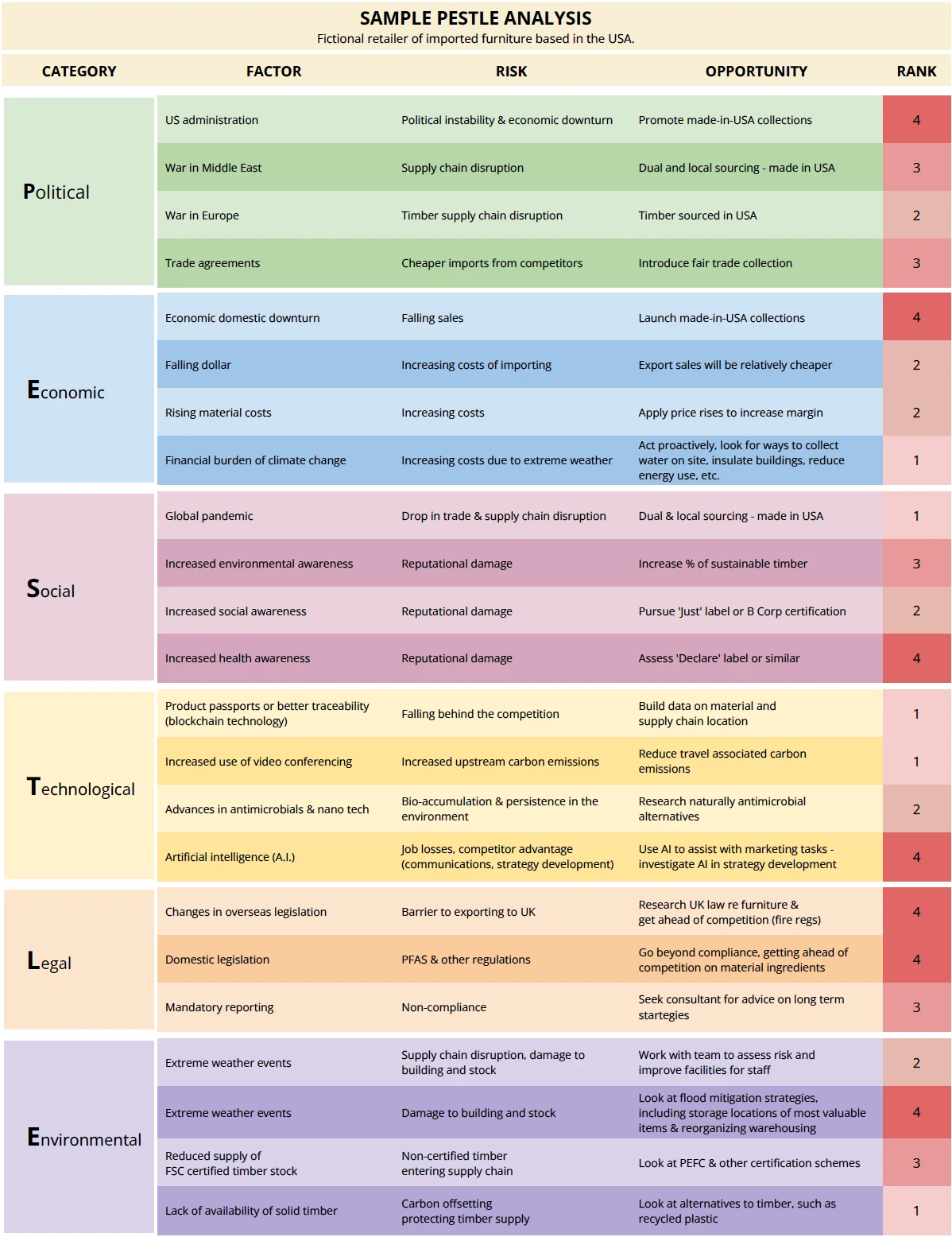
Table 2. This is a sample PESTLE analysis for a fictional retailer of imported furniture based in the USA. In each of the 6 categories, the company identified one or more opportunities to flip a risk into a positive. In the ‘Political’ category, for example, disruption in the timber supply chain due to the ongoing war in Europe is identified as a risk; the related opportunity identified is to source timber domestically in the United States. In the ‘Social’ category, increases in environmental awareness is identified as a topic, reputational damage as a risk and increasing the amount of sustainably sourced timber as an opportunity. In the ‘Legal’ category, the company selected mandatory reporting as the topic, non-compliance as the risk, and then flipped this into an opportunity to get ahead of the game by bringing in a consultant to develop a long-term strategy.
3. RISK & OPPORTUNITY REGISTER
Alongside SWOT and PESTLE, a third tool for identifying risks and opportunities is the aptly named risk and opportunities register. Through this methodology, companies rank risks so as to focus on the highest ones. This is designed to assess a wide range of risks facing a business - not limited to environmental or social issues. This approach allows companies to evaluate risk in terms of wider company strategy, then record the intended measures to mitigate those risks along with any associated legal obligations and opportunities for action. You might want to check with your compliance team to see if a risk and opportunities register is already in place.
The Risk & Opportunity register lists material topics by category and describes the associated risks. These risks are rated in terms of impact and likelihood, then multiplied to create a ‘risk significance’ level. Some companies might add another column to show the level of risk for each materiality topic when controls have been put in place. The risk of contributing to climate change would be high, for example, for a company shipping goods by road all over the USA. Meantime, if the control to reduce this risk were to build an electric fleet, this would become a significantly lower risk.
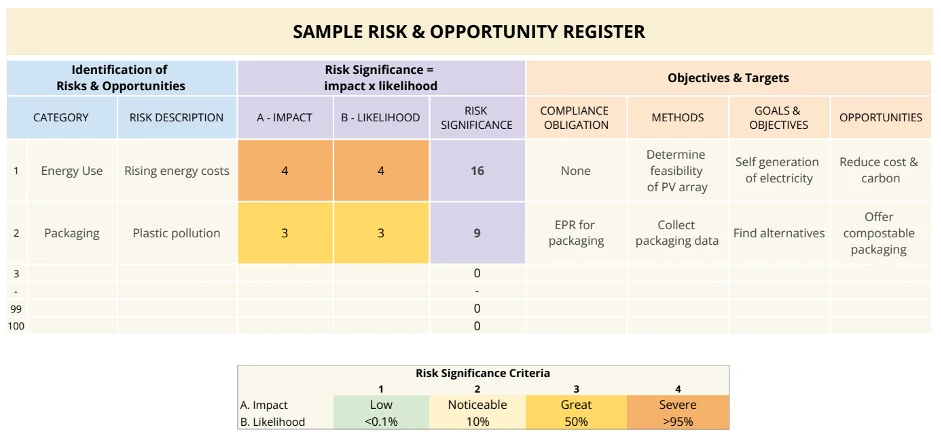
Table 3. This is an example of a Risk and Opportunity Register. There are two example topics, packaging and energy use, alongside the associated risks of each. Energy use involves the risk of rising energy costs, while a stakeholder concern would be increased costs and potential impact of reduced profits. There are, as yet, no compliance obligations for energy use for this fictional company but the action given to this topic is to determine the feasibility of installing solar panels. With an objective to generate electricity on site, an opportunity emerges to reduce both operational carbon and spending on purchased power.
To help inspire you as to the opportunities that might be available to your company, look at the sustainability reports of lots of furniture-related companies. Most are readily available on-line. Look for ideas among the opportunities identified by others and what could work for your business. The more you look at what other companies are doing to flip risks into opportunities, the closer you will get to a clear strategy that is fundamental to your sustainability journey.
6 furniture companies turning opportunities into action
Take a look at these examples of opportunities identified by six furniture manufacturers and retailers. Note how each organization grasped an opportunity by the horns to take action to bring about significant change.
1. Steelcase
Here are four examples from Steelcase that illustrate how data collection has led to multiple sustainability shifts. While it is commonplace to think of sustainability as an added cost, you’ll see in most of these examples that environmental impact reduction in fact often goes hand-in-hand with cost savings.
- As part of its DEI - diversity, equity & inclusion - strategy, Steelcase conducted an analysis of employee diversity at each job level - with an eye toward identifying opportunities for improvement. The data led to a prioritization of skills-based hiring practices and a redesign of its team structure and talent acquisition strategy. The company also found that engaging current employees in the hiring process helps to build more diverse teams.
- Data collected on the production of waste materials led Steelcase to identify an opportunity to reduce powder coat waste. In collaboration with a key paint supplier, Steelcase found a solution that resulted in a 91% reduction - equivalent to 97,000 pounds - in powder coat waste going into landfill.
- In Steelcase’s Michigan factory, 85% of its waste is scrap from manufacturing. By measuring and reporting on this, teams were able to identify opportunities to reduce scrap steel by 28%. This is a reminder of the age-old adage ‘what gets measured gets managed.’ Steelcase’s response not only reduces the amount of scrap waste produced, but also reduces the cost of steel waste management and reduces the company's expenditures on virgin steel inputs.
- By tracking both costs and carbon emissions related to product distribution, Steelcase saw patterns that led them to make significant changes through a transition to eco-smart packaging. Chairs can now be stacked six high in transit, taking up less space - resulting in fewer journeys and less carbon.
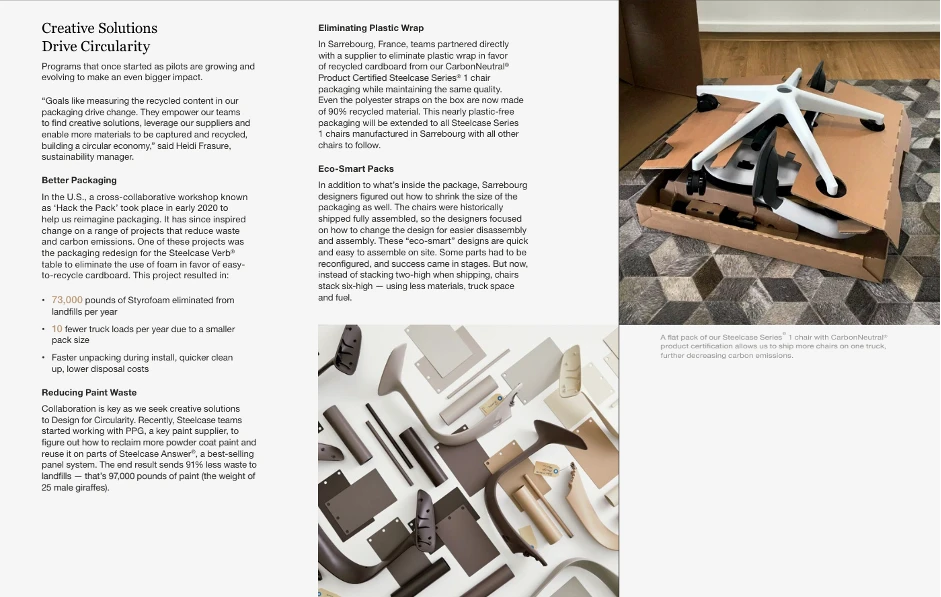
Steelcase’s 2023 Impact Report details significant reductions in waste of both powder coating and packaging.
2. Room & Board
Through the process of pursuing B Corp certification, Room & Board identified an opportunity to expand transparency around its business practices with both customers and employees. The company now holds itself accountable for continued improvement, having become B Corp certified in 2023.
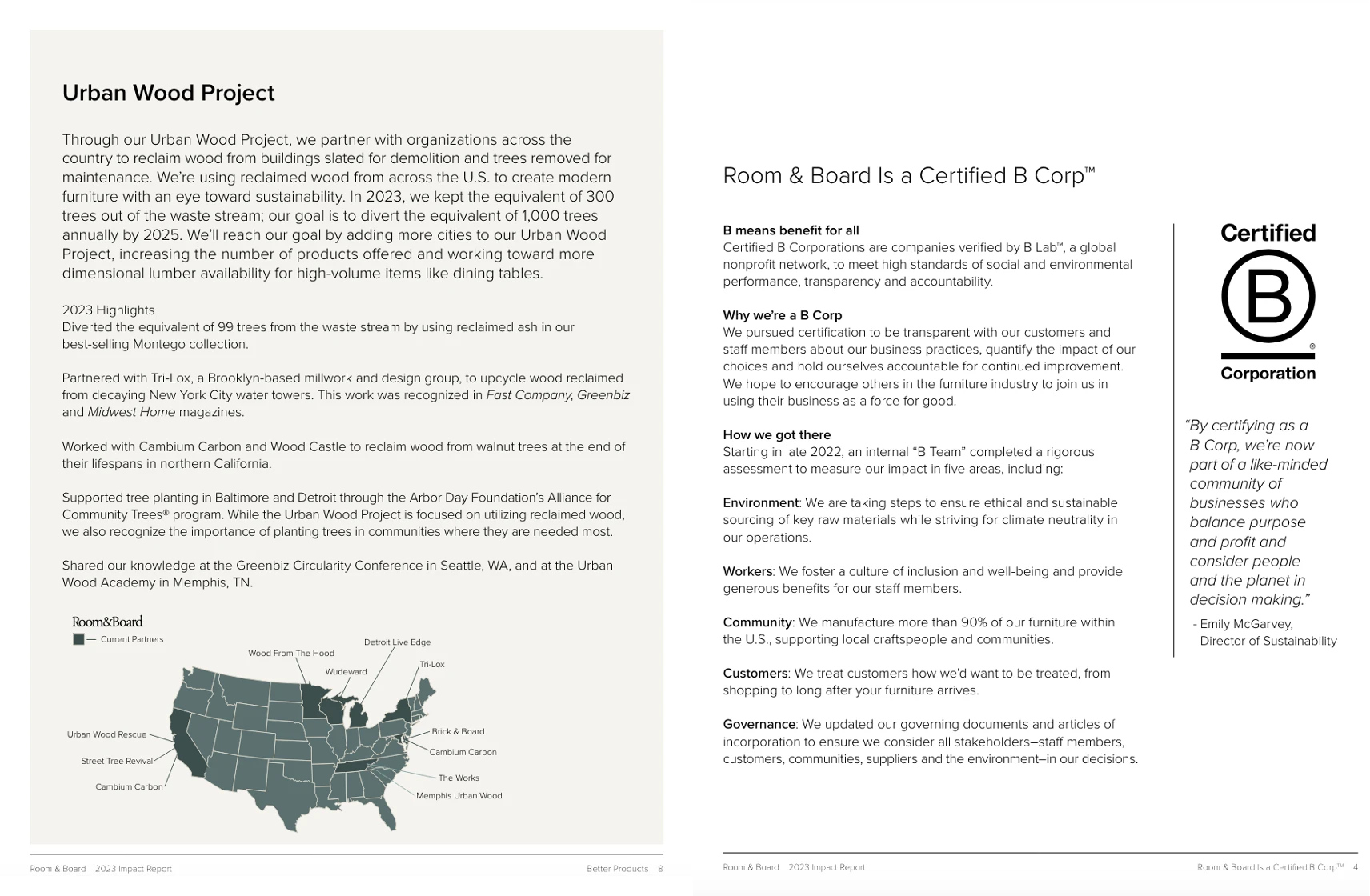
Room & Board identified B Corp certification as a good business and sustainability opportunity. The company also expanded the reach of its Urban Wood Project that makes use of felled trees and reclaimed wood.
That same year, Room & Board expanded its Urban Wood Project to New York City. Through this project, the company partners with organizations across the US to reclaim wood from buildings earmarked for demolition and urban trees removed for maintenance. With this wood source, Room & Board extended its line of reclaimed furniture, which led to environmental gains as well as a great storytelling opportunity.
3. Humanscale
In its 2022 CSR report, Humanscale identified a range of sustainability opportunities for 2023. These included introducing additional products that use ocean plastic, following the launch of its ‘Path’ chair; piloting a circular-product business model; and eliminating added antimicrobials. These opportunities came alongside more typical energy, water and waste reduction measures that lower costs as well as impacts.
Humanscale plans to evaluate its products for their climate impacts, using data driven life-cycle assessments and developing net positive plans - striving for products to have a positive ecological ‘handprint’ that outweighs their negative environmental ‘footprint.’
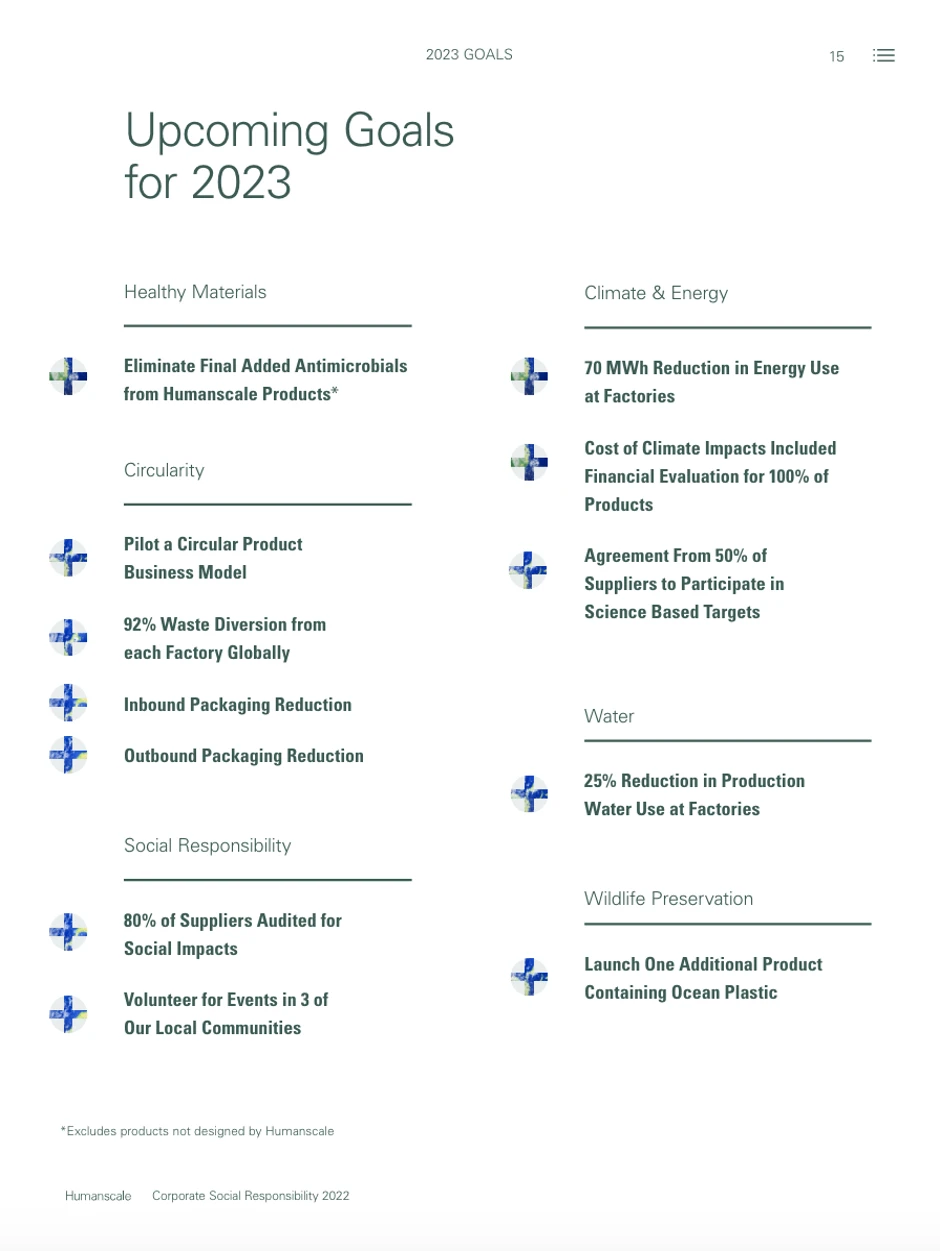
Humanscale’s 2023 goals have been organized into 6 sections: healthy materials, circularity, social responsibility, climate and energy, water and wildlife preservation. Under the circularity umbrella, they have set a specific goal of 92% waste diversion - the baseline for which was likely set by tracking of waste to landfill. Similarly, they have set a goal of 70MWh reduction in energy use.
Perhaps the most significant opportunity put into action by Humanscale resulted from its tracking of use of non-renewable materials. By gaining visibility into the sheer volume of its non-renewable inputs, Humanscale was able to identify that a change was needed and developed a strategy around increasing its use of recycled inputs. This eventually led to the development of the Path chair, a task chair with a high percentage of recycled content.

Humanscale uses millions of kilos of raw materials each year. Non-renewable materials are extremely high in embodied impacts because of the vast amounts of energy it takes to mine them. Using recycled materials reduces the energy inputs required to produce materials. In 2018 Humanscale used almost 23 million kg of non-renewable materials, only 23.5% of which were recycled. In 2020 the use of recycled materials rose to 33.6%. By 2022 recycled material inputs had risen to 39%. By increasing the amount of recycled material inputs, Humanscale has reduced the amount of virgin materials it uses by over 7.5 million kg between 2018 and 2022.
4. Floyd
Floyd, a Detroit-based manufacturer, identified resale as an opportunity to take back its own products, then refurbish and resell them. Increased interest in reuse and circular product design is being tapped by small manufacturers and even corporate furniture giants like IKEA. It is useful to see what other players in the world of furniture are planning as a means of scouting opportunities for improving your business resilience. Circularity is definitely here to stay.
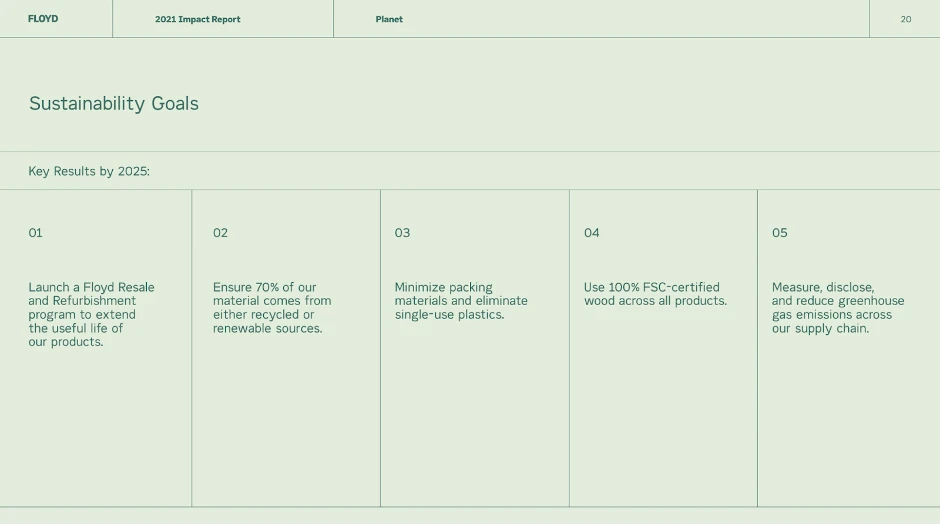
In its 2021 Impact Report, Floyd is very clear about its goals for the next three years. Note the company’s commitment to launching a resale and refurbishment program, likely an opportunity it selected via a self-evaluation and reporting process.
5. Williams Sonoma
Among its goals for 2022, Williams Sonoma identified an opportunity in ethical and fairly traded products. Growing consumer consciousness surrounding labor standards, human rights abuses and the income gap between the Global North and South has created a need for greater due diligence along a company’s supply chain. This, in turn, provides an opportunity for Williams Sonoma to showcase best practices along its supply chain, which - as noted in this example - elevate worker rights, pay and recognition.

In 2022, Williams Sonoma identified opportunities to make progress in ethical and fairly traded products. In reporting, the company was able to showcase several best practices along its supply chain in areas such as workers rights, pay and recognition.
6. Modus
In tracking its carbon emissions, British contract furniture manufacturer Modus noticed that its scope 2 emissions - from purchased electricity - were responsible for a large proportion of its carbon footprint. This led the company to switch to a renewable energy supply in 2019 and the installation of solar panels on its factory roof in 2022 which now supply almost 40% of its electricity.
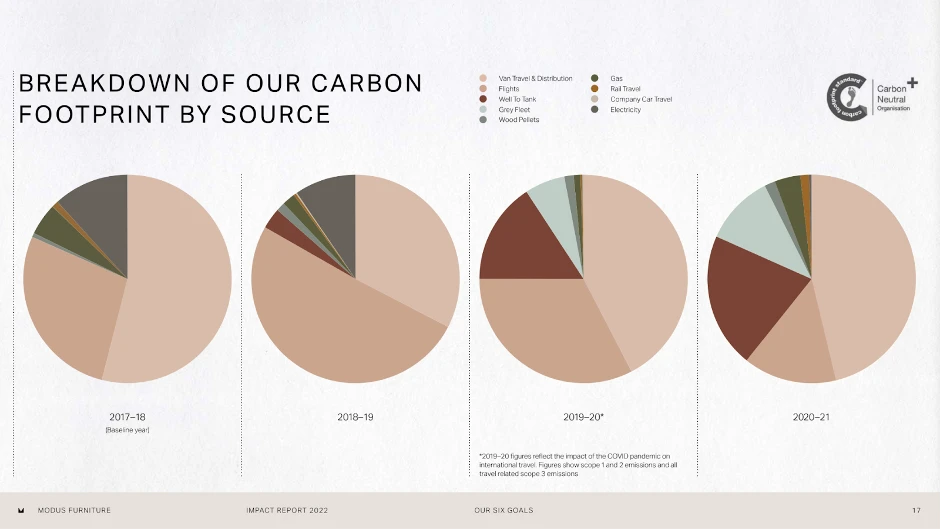
In its 2022 Impact Report, Modus uses pie charts to show carbon emissions by source. The dark gray slice shows emissions associated with electricity use. Note how this slice shrinks in 2020 when the company transitioned to renewable electricity.
Creating a roadmap for change
Identifying opportunities is the first step. Setting targets is the second. Creating a plan of how you will reach those targets is the third. This is where a sustainability roadmap comes in.
A roadmap offers specifics as to how your company will reach its goals and targets. The roadmap offers a vision, detailing the series of steps needed for a company to reach its goals. It is a timeline that breaks down overarching goals into smaller, more achievable targets. Publishing a roadmap that includes current progress is one of the best ways to show the world what you plan to do and how you plan to do it, allowing everyone inside and outside your organization to see your impact reduction plans. If you want to see where a company plans on going - go straight to its roadmap or progress-against-targets page.
To create your sustainability roadmap you will need to:
- Define a clear strategy - What are you hoping to achieve and why? It helps to organize your goals and objectives into themes.
- Set SMART targets - These are targets that are Specific, Measurable (sometimes qualitative rather than quantitative), Ambitious (‘Achievable’ won't be enough to avert the worst impacts of climate change), Relevant to your unique business, and Time bound. Determining SMART targets is the hardest part of the reporting process and may take several weeks to get right. Ask yourself ‘What do we need to achieve to be proud of our sustainability efforts?’
- Plan out your company’s journey - your objective, for example, might be to avoid any kind of pollution, including waste to landfill; your goal might be to vastly improve your plastic-reliant packaging; and your target could be to eliminate the use of any non-recycled plastic packaging by 2025.
A roadmap notes your current position on this particular road, where you plan to be the following year, and how you might reach your ultimate target. A roadmap is, if you like, a series of mini-targets or steps along the way to reaching the end goal. Absolutely central to your roadmap will be the ACTIONS you need to take to reach each target. This might be something you want to be completely transparent about and include on your roadmap, or you may want to keep a RAL (rolling action list) to yourself, communicating your objectives, goals and targets but keeping the granular detail confidential within the company.
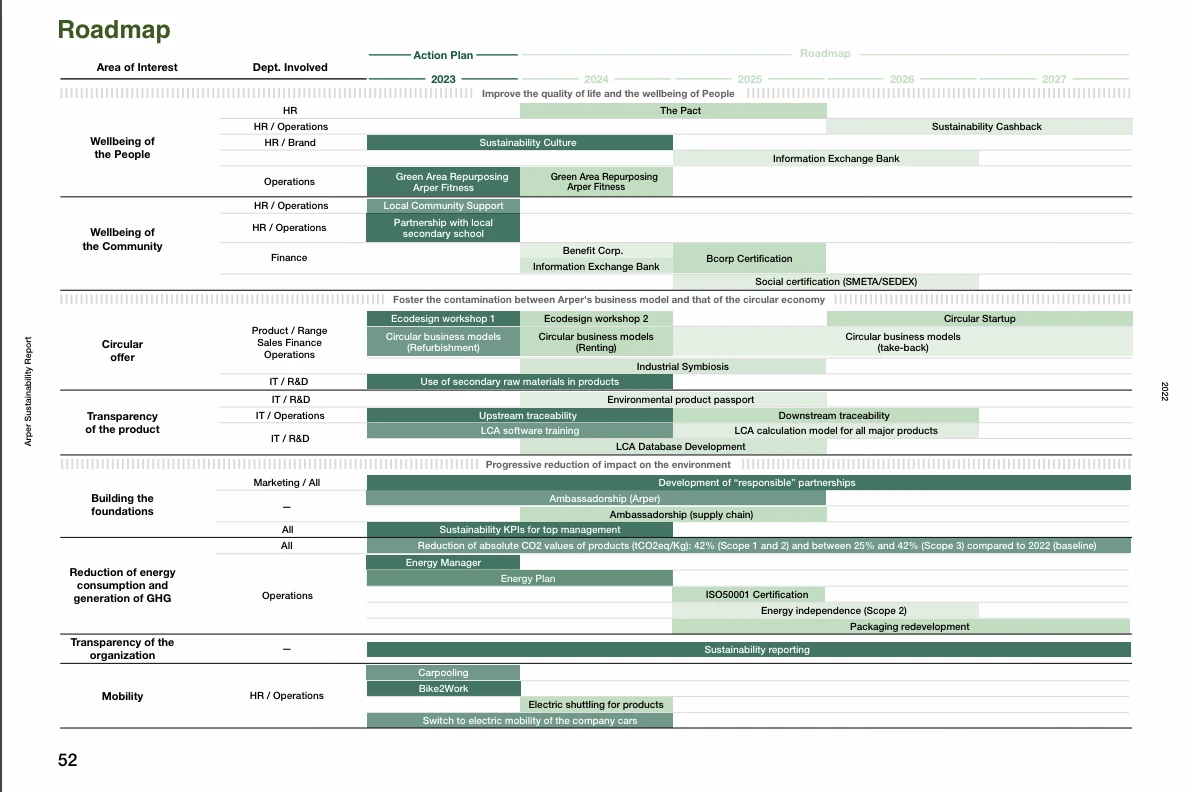
In its 2022 Sustainability Report, Arper - a European furniture brand - sets out a roadmap of targets for the years ahead. It is divided into targets for the coming year and then for 2023-27. Under the topic of ‘wellbeing of the community,’ for example, Arper identified ‘local community support and partnership with local secondary schools’ for 2023, with the plan of working towards B Corporation certification through 2024 and a target of becoming B Corp certified in 2025. Note how Arper has identified which departments are involved in each step.
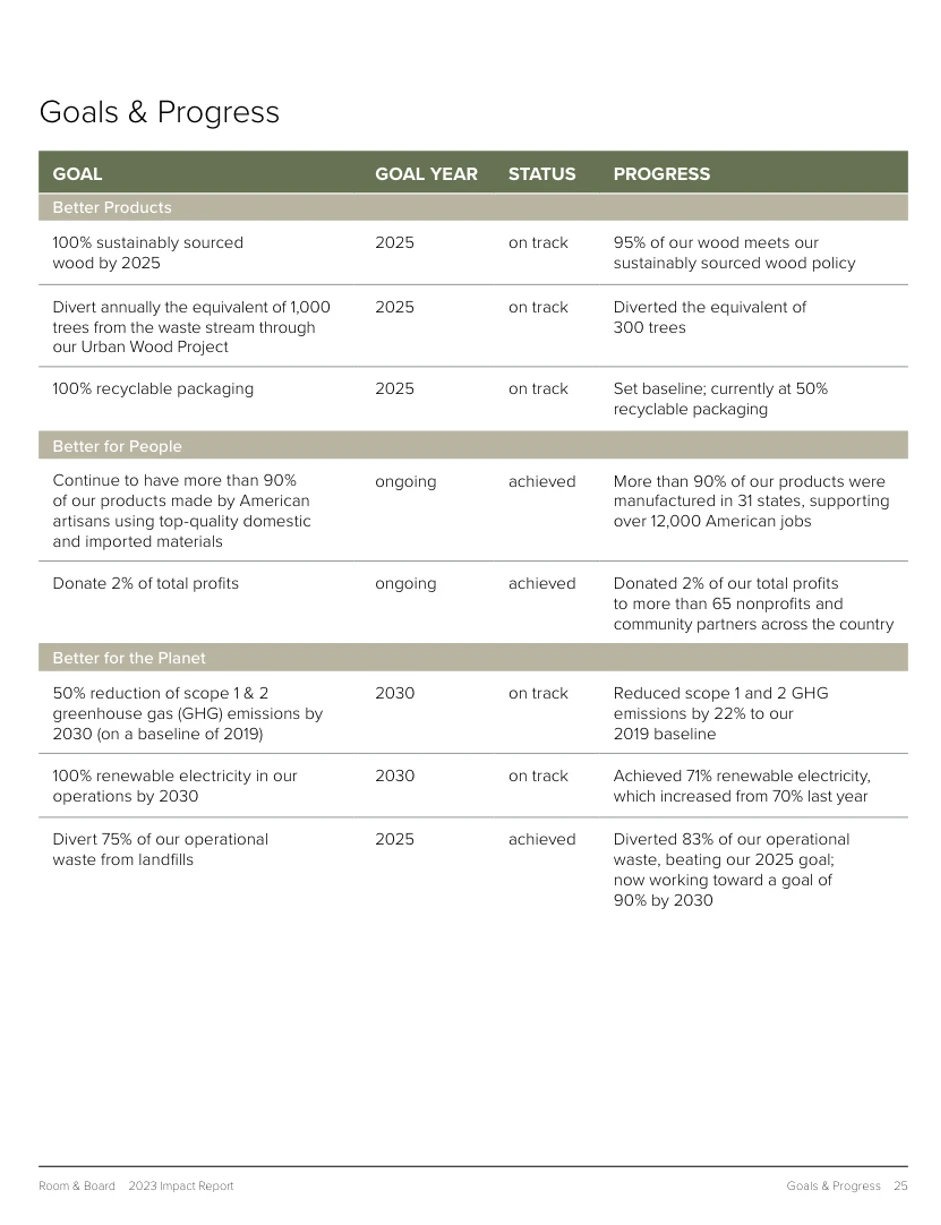
In its 2022 Impact Report, Room & Board set out a series of goals, their status - on track, off track and achieved - and a description of progress against target. This kind of roadmap keeps companies on track, explains clearly to internal teams and the outside world how they are performing, and acts as a strong narrative telling their sustainability story.
A roadmap is not a fixed and immovable set of steps. It is a living document that will evolve over time as you encounter fresh ideas and the sustainability landscape shifts. Your roadmap is a flexible tool to keep you on target and in step with your strategy.
Using sustainability frameworks to build your roadmap
To help build a clear sustainability strategy and a roadmap to keep you on track, look at sustainability frameworks such as the United Nations Sustainable Development Goals (UN SDGs), or the disclosure topics for furniture listed by the Sustainability Accounting Standards Board (SASB). Frameworks set out the principles that can aid decision making and can help ensure that your sustainability strategy is well rounded and well structured.
1. Sustainability Accounting Standards Board (SASB)
The SASB disclosure topics for furniture is a group of topics that the SASB recommends furniture companies report on. Taking the SASB framework as an example, we can illustrate how each disclosure topic might reveal an opportunity:
Energy management in manufacturing offers the opportunity for self generating electricity, purchasing renewable electricity and implementing energy efficiency measures.
Management of chemicals in products offers the opportunity to adopt product ingredient disclosure and certification through schemes like the Declare label, Living Product Challenge and health product declaration (HPD) labels, such as Greenguard and Cradle-to-Cradle Certified.
Product lifecycle environmental impacts could offer opportunities - such as those harnessed by furniture-maker Humanscale - to use information around lifecycle impacts to create ‘net-positive’ furniture. Or this information could be used to create water or carbon environmental footprints, giving manufacturers and retailers a competitive edge.
Wood supply chain management could provide potential for FSC or other certified timber purchasing, or the further incorporation of reused timber such as through Room & Board’s Urban Wood Project.
2. United Nations Sustainable Development Goals (UN SDGs)
The United Nations Sustainable Development Goals (‘SDGs’) are a set of 17 goals that have been carefully developed as a ‘universal call to action to end poverty, protect the planet, and ensure that by 2030 all people enjoy peace and prosperity.’ Each goal is broken down into separate targets that help guide decision-making.
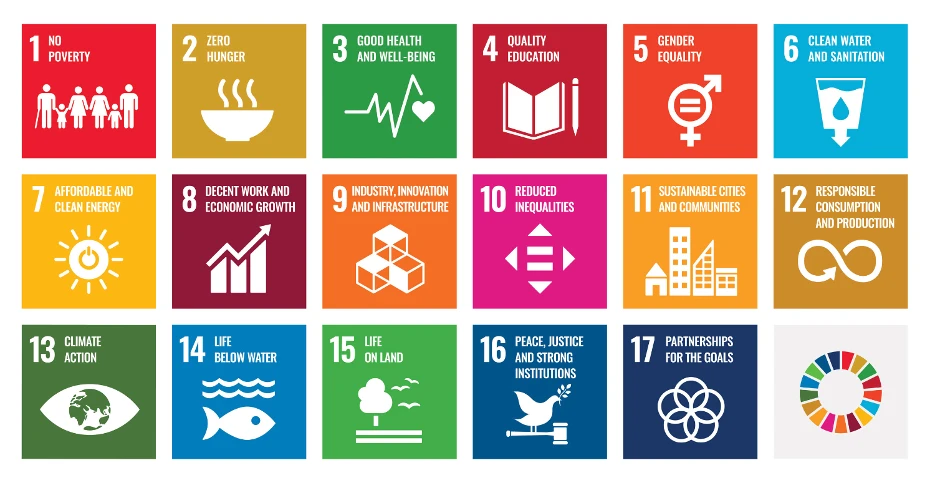
The SDGs also provide a detailed framework for action that can help companies unearth opportunities. SDG 14 / Life Below Water, for example, could inspire a company to use fabrics made from marine plastic. SDG 4 / Quality Education could inspire a company to sponsor a college program, set up an apprenticeship scheme or donate furniture to a school in an under-served local community or less developed country.
Impact reporting provides a serious avenue to greater accountability for your company and, ultimately, for the furniture industry as a whole.
Once you have defined your impacts, built a strategy around them, set your goals and targets and created a roadmap to help you reach your destination - you will inevitably end up with a huge list of actions!
This becomes an internal to-do list, as it is likely too big and detailed to include in your published roadmap, and also needs to show which individuals are responsible and accountable for each action. This is the list you will reach for again and again, showing you everything you need to do to keep up with the timeline set out in your roadmap.
Action is at the heart of every sustainability journey. Often the real work of implementing the actual interventions will be carried out by a completely different set of people than those who identified your impacts and defined your company’s targets and goals. Keep communicating your end goals, bringing everyone on board and celebrating achievements along the way. Pin your roadmap up on the wall so everyone can see where your company is on its journey and what is left to be done.
The key to achieving true ‘impact’ is action. The shift we need - toward an environmentally and climate aligned furniture industry - requires companies to look closely at their impacts and the associated risks. Significant progress also demands an opportunistic outlook - one that asks ‘What can be done differently?’and ‘How can we turn this into something positive?’ A company’s decision to become more transparent and accountable offers up incredible potential for a radical shift.
We need to learn to see and do things differently, recognizing the vast number of opportunities open to us as individuals, as companies and as an industry.
-------------------------
Our 3-part series on impact reporting set out to guide you through the reporting process, inspiring you with some great examples of real impact reports and giving you the confidence to make a start on building your own. The series covered key content to include, methods for identifying and prioritizing your impacts, and tools for turning challenges into opportunities and building a roadmap for change.
Perhaps this would be a good time to look back over the three Action Guides and two Webinars in the series.
READ Action Guide #1: The What, How and Why of Impact Reporting
WATCH Webinar #1:
READ Action Guide #2: Understanding Your Impacts
WATCH Webinar #2:
Pick your favorite bits from these resources to help keep you and your teams inspired! Take advantage of this series as an invitation to become more accountable and to become part of the movement for change.
SOURCES
The Lancet - Planetary Health
Declare. The Nutrition Label for Products
